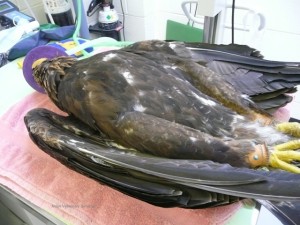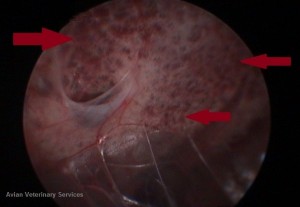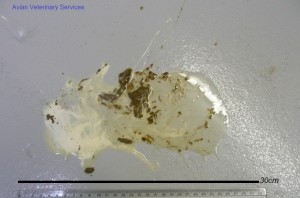
A few recent cases have alerted us to potential problems with inhaled toxins/irritants in birds of prey.

Optimal ventilation with the provision of ‘fresh air’ is essential in all animals; though with the birds’ unique respiratory tract of air sacs ventilating a static lung it is even more critical. Their specialized respiratory system is able to extract the massive amounts of oxygen required for flight; however it also has the ability to concentrate inhaled toxins/irritants/infectious agents such as natural gas, fungal spores, carbon monoxide, PTFE (e.g. Teflon), exhaust fumes, ammonia or a variety of solvents used in aerosols we don’t even know about yet! This is in fact why, in days gone by, canaries in cages were taken down into the coal mines as sensitive ‘gas detectors’; if they passed out or even died, the miners were entering a potentially dangerous area.

Basically if we can detect a ‘strong odour’ with our comparatively poor sense of smell, it will be far, far worse for birds.
Generally well designed aviaries have adequate ventilation; however one possible area of concern is the relative confinement of birds in travel boxes for even quite short periods. Although the majority of boxes have ‘ventilation holes’ potentially dangerous levels of exhaled carbon dioxide, and ammonia from mutes can build-up resulting in damage to the delicate tissues of the lung.

(Research ‘harmful effects of ammonia on birds’ for more information as this is a big issue in the poultry industry). This is even more of a problem if the boxes are not regularly cleaned to remove ‘all’ of the uric acid (white part of the droppings) that can be degraded by bacteria to produce more ammonia, with contaminated boxes also prone to fungal growth.
The following case illustrates a situation where a golden eagle in a large transport box suffered what we believe to be an inhaled irritant/toxic event, triggered presumably by the inhalation of relatively high levels of ammonia. The bird presented in severe respiratory distress at which point it was admitted for supportive/oxygen therapy with view to blood work, x-ray and endoscopy to try and establish an underlying cause.

X-rays and blood work (including lead levels) were all normal with the only relevant finding on endoscopic examination severe oedema/congestion (fluid build-up and bleeding) of the lung. There was no evidence of aspergillosis (a fungal infection of the respiratory tract that eagles are susceptible to) and based on the clinical findings, elimination of other potential causes and recent history of being in the travel box more than usual we suspected inhaled irritant/toxicosis in this case.
Thankfully with intensive supportive therapy including oxygen supplementation, diuretics, anti-inflammatories and preventative antifungals this bird made a full recovery despite the quite severe lung changes evident on endoscopy.
In other similar cases the lung changes seemed concentrated around the ostia (basically the inlet valve of the lung and as such suggests an inhaled cause as this would be the first part of the lung exposed to the irritant).
Although virtually impossible to prove, lesions on lung tissue samples from cases that were not so lucky, have been submitted to an avian pathologist for testing and the reports seem to suggest trauma from an inhaled irritant such as ammonia. In addition some very basic testing of mute contaminated boxes using ammonia test strips has shown some quite alarming levels.
Although thankfully pretty rare this issue does seem to be over-represented in the large birds such as eagles (which given the relative sizes of bird and box (particularly if required to fit in a vehicle) and large volume of mutes passed are seemingly more at risk) however we have seen it in birds the size of Harris Hawks.
Given the above it makes sense to:
1. Always bear in mind if something smells strong/irritating to us it will be far, far worse for the bird.
2. Only use transport boxes when absolutely essential.
3. Ensure appropriate ventilation for birds at all times including transport. Stick your nose in the box and if it smells to us with the door open it will be much, much worse for the bird especially with the door closed.
4. Consider the use of absorbent pads such as kennel liners/puppy pads in the box to soak up mutes/droppings.
5. Consider the use of a transport box ventilation system. These devices (basically a small electric extraction fan that will plug into a cigarette lighter) are commercially available and can be applied to most boxes. We use such a ventilation system from KTB in our hospital units to good effect.
6. Contact your avian vet immediately if your bird is showing respiratory signs as the sooner they get a diagnosis and begin appropriate therapy the more likely the bird will make a complete recovery.
Addendum;
Following discussion with a specialist zoo and wildlife pathologist, dust from sand, plaster, cement or cat litter for example, used in poorly ventilated areas or situations of temporary confinement e.g. transport boxes, can cause significant damage to the extremely sensitive avian respiratory tract, especially as turbulence from a flapping wing can easily stir up this particulate matter which is then rapidly inhaled.
As such, the bottom line is still appropriate ventilation at ALL times is essential to the well being of our birds, especially in the case of performance athletes which our falconry birds are.
